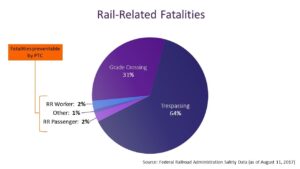Three Reasons Why PTC is Only Part of the Solution
October 15, 2018

In less than three months, there have been multiple high-profile train accidents. Each time, images of mangled cars and wreckage flooded the Internet. As the CEO of a company that offers smart technology solutions for the rail industry, I have had to ask myself, “What steps can my team at Wi-Tronix and I take to help prevent these types of accidents?”
I believe that those of us who develop technologies that can help save lives immediately have a responsibility to communicate more clearly about those options—and engage more openly with the rail industry and lawmakers about alternative approaches to accelerate rail safety.
Tragedies such as the recent train accidents and fatalities tend to magnify focus on PTC and the difficulty in meeting the Federal mandate to implement it. As someone who sits at the intersection of rail and technology, I am concerned by how this narrative plays out in the public arena. It erroneously paints the picture that PTC can eliminate all train accidents and is the antidote for rail safety. PTC is not a panacea, and understanding what it is —and its limitations— is critical to getting the Rail industry to adopt ongoing safety improvements.
Positive Train Control is a complex interface of railroad equipment, infrastructure, and technology. As a fully functional system, it uses GPS, Wi-Fi, and a proprietary, low-speed (1G) radio network to know exactly where a locomotive is and its proximity to potential problems. If an engineer does not take the necessary steps, such as slowing down in a speed limited zone, the technology will bring the train to a stop.
Is PTC vital? Absolutely. PTC is an important tool to avoid train-to-train collisions and to ensure trains do not go too fast. However, these are far from the only safety risks that a train faces. For example, the accident in Virginia, where a train struck a garbage truck, would not have been prevented by PTC, because the accident was not caused by a factor of speed or proximity to another train.
If we truly want to improve rail safety, we must consider its limits.

- PTC addresses only 35% of rail accidents and less than 10% of deaths. At the end of this year, all railroads operating on high-risk routes are required to have PTC fully implemented and functional. After several billion dollars of private capital being invested to install this complex system, there will still be significant unaddressed safety concerns. Public perception of the federal mandate sets up a false belief that once PTC is fully implemented, train accidents will be eliminated. However, PTC doesn’t know if a teenager wearing headphones is walking on the tracks or if a car is stalled at a rail crossing.These two scenarios alone account for the majority of fatalities and injuries along a railway.
- PTC is one-size-fits-all. In 2016, over 37,000 lives were taken by automobile accidents. In the same year, there were less than 800 fatalities on railroads. In the rail industry, Congress has mandated that railroads spend billions of dollars to implement PTC to address train speed and avoid train-to-train collisions. In the automotive industry, Congress and regulators are using a relatively light touch. Automakers are encouraged to pursue autonomous vehicles and assisted driving technology to improve safety and reduce the high number of deaths. Automakers have more freedom to design the vehicles and technology on their own. On the other hand, railroads are required to implement one prescribed solution. I think the approach taken by regulators and Congress toward automakers makes sense. It encourages innovation and market-based solutions to answer safety concerns. If a similar standard were applied to rail companies, I believe the solutions would be impressive.
- PTC is a drain on resources. The Rail industry will invest more than $10 billion on PTC by the time it’s fully implemented, and hundreds of millions of dollars per year to maintain the system. As I’ve argued, PTC can only solve someof their safety concerns, yet rail companies are forced to pay for this complicated, narrowly-focused system. This means there is less money available to invest in other technologies to address a broader set of rail safety concerns like improving crossing safety, engineer distraction, physical security, and infrastructure monitoring.
With the PTC mandate, I fear that railroads are racing toward compliance instead of racing toward safety.
Studies show that the approach being taken in the automotive industry is immediately improving safety. Implementing simple, pragmatic solutions such as parental alerts when a teenager is speeding, or audible warnings when there is a car in your blindspot, result in less at-risk behaviors and fewer accidents.
PTC is limited in what it can prevent, so the rail industry needs to take a similar approach to solving the broader scope of safety concerns. My company, Wi-Tronix, has focused significant energy into identifying pragmatic solutions that have proven to immediately improve safety for our clients. I encourage Rail industry leaders and legislators to consider the importance of these types of solutions, and reach out to technology innovators to assist with more fully addressing the safety challenges of the Rail industry.
